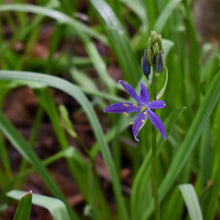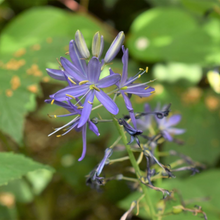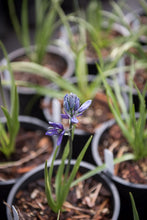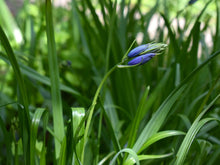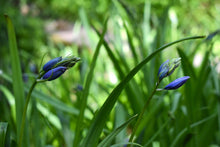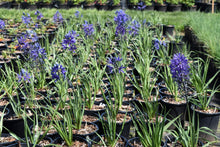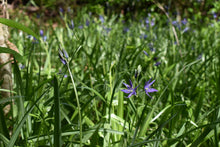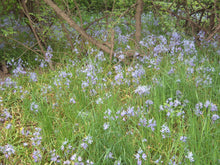
Camassia quamash
Common camas is an attractive and versatile spring bulb. Countless star-shaped, blue-purple flowers explode into bloom atop erect, tall stems each spring. The bright yellow pollen within is both ornamental and attractive to beneficial insects, pollinators and hummingbirds. A true Oregonian, it perfectly evolved to thrive being inundated with water in the winters and bone dry in the summers. The bulbs are also edible, extremely high in protein, and delicious and are an important plant for indigenous peoples.
- Plant type/canopy layer: deciduous, perennial, herbaceous plant
- Size at maturity: 30" tall, 6-12" wide
- Light requirements: full sun, part sun/part shade
- Moisture requirements: moist to wet winters, dry summers
- Bloom time: April - July (April - June in the Portland Metro area)
- Growth rate/ease: medium growth rate, easy to grow
- Wildlife support: flowers attract and provide nectar for hummingbirds, adult butterflies, bees and other insect pollinators; overall plant supports beneficial and pest eating insects
- Native habitat/range: common in meadows, bogs, fens, wetlands and vernal pools. There are eight subspecies of C. quamash, and between them the species covers most of the Pacific Northwest. Portland Plant List - yes.
- Special features & uses: edible, supports hummingbirds
What to Expect + Gardening with Common Camas: For spring orders, depending on the weather and the date of your order pick-up, bulbs may be just emerging or already dying back for the season. Bulbs can be fragile when they're actively growing in spring. So, either plant with care or keep it in its pot and wait until it dies back before planting. By early summer, the plant will die back completely and the bulb will be easy to transplant. If you go this route, leave the pot in a sheltered place and water sparingly, so that you don't rot the bulb. For fall orders, you can expect what looks like a pot of dirt. The bulb inside may appear slightly shriveled, which is its normal, dormant fall look. Fall is generally considered an ideal time to plant bulbs.
This beauty is the crown jewel of the sunny raingarden or meadowscape, as well as an excellent replacement for conventional, ornamental spring bulbs. It does great with winter flooding, and even some shade, provided it can dry out and bask in the summer sun. After blooming, common camas die back completely, so it's ideal to intermix this plant among other perennials and wildflowers that will take the stage once camas’ glory has passed.
Photo Credits 1, 2, 4 - 7: Nikkie West, Sparrowhawk Native Plants
Photo Credit 3: Hoddick Photography
Photo Credit 8: "Camas" by born1945 is licensed under CC BY 2.0








